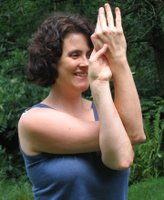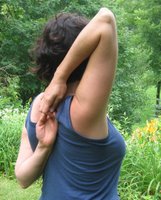(This week, my digital camera is on a field trip to Madison, taking pictures of rocks for a geologist. In order to stay on schedule, I’m going to post this without pictures and will try to add some visual information this weekend. Sorry-bkp.) I sort of left you hanging last week, with only the upper part of your body warmed and stretched. However, I didn’t want to have a gigantic blog entry and overload you with information. Now we’re ready to address the lower back and legs, which are the main supporters of all the standing poses (i.e. Trikonasana-triangle pose, Virabhadrasana-warrior poses, etc.).
A good place to start bringing awareness to the large muscles of the legs is Dandasana (Staff pose). The pose is relatively simple, sitting with the spine aligned and the legs extended, but an engaged Staff gets blood flowing into the legs and energizes the torso with the effort it takes to sit tall and ground through the back of the legs. If you combine it with an arm stretch (Hastasana-overhead arm stretch, for example) it becomes a very active way to work most of the muscles at once.
I usually include Padangusthasana (Hand-to-Big Toe Pose) at the beginning of class because it opens the back of the legs (hamstrings in the thighs and the gastrocnemius of the calf). As you lie on the floor, concentrate on maintaining the lumbar curve in the lower back (about enough space for your fingers) and ground down through the back of the hips. This keeps the pelvis level and increases the stretch in the back of the thighs. As you lift one leg, make sure to keep the leg on the floor as engaged as the leg that is stretching; this will increase the stretch and keep you balanced when you open your foot to the side. Give yourself time to open in this pose; this is one you don’t want to rush (as if any of them are), because the more you ease into it, the more length you will get out of your legs.
A combination of the two proceeding poses is Paschimottanasana (Seated Forward Bend). In this position you keep the spine long as in Staff, while stretching the soles of the feet evenly away from you and grounding the backs of the legs as in Hand-To-Big-Toe. Bend at the hip crease, where the thighbone connects to the pelvis, instead of rounding the lower back. There isn’t a lot of forward movement in this stretch, but if it follows Hand-To-Big-Toe, you will notice more length in the back of the legs. If your lower back is flexible, you can eventually let the spine soften and round toward the legs into a more supported stretch.
The front of the thigh (quads) is the focus of Virasana (Hero Pose). Give yourself some help by lifting the sit bones with a folded blanket or block. It is very difficult to actually sit on the floor between the heels and often people let the lower back round in order to do so. Avoid this temptation, and notice how much taller you can sit if you lift your seat a bit. Try to let your exhales release the muscles in the hip joints, which will also let you lengthen the spine.
One last area to focus on is your back. Many of the seated positions require work of the abdominals in the side body to keep the spine aligned, but a little attention to the muscles running along side the spine will prepare you for later twists like Parsvakonasana-(Lateral Angle) or Marichyasana (Seated Twist and Forward Bend). Bhujangasana (Cobra) and Salabhasana (Locust) are baby back bends that open the chest while working the back muscles to lift the upper torso and, in the case of Locust, the legs. You can try various modifications to make them easier (using the hands to support the chest in Cobra or keeping the arms to the side in Locust) or harder (crossing the arms at the lower back for Cobra or lifting the arms out to the front in Locust), depending on your target pose.
Take to time to prepare yourself for your later, more challenging poses. The more work you do on the floor, the more confidence you will have when you come to your feet or hands or head (!) in the center of the room. These preparatory poses have their own integrity and, if practiced with a quiet focus, are beneficial even if they don’t lead to something more difficult. Some days you want to shake and sweat; others you just want to quietly extend. And no matter what, always give yourself a few moments for a complete relaxation at the end of your practice so that your body has a chance to recuperate and release. Namaste (said with an enthusiastic exhale, because that was a lot of information to get through!)
©Brenda K. Plakans. All Rights Reserved.





